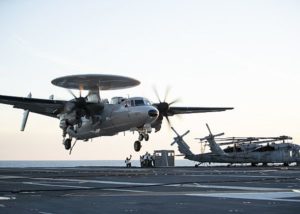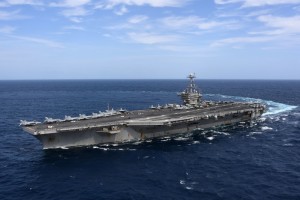The Navy’s $2 billion fiscal year 2024 unfunded priorities list it sent to Congress focuses on capabilities to make the fleet more capable in a high-end fight.
The top four items listed on the list are all related to the Chief of Naval Operations’ focus on capability. The other items are largely under topics of readiness with one additional aircraft to add capacity.

This 11 item list is significantly less than the $4 billion list the Navy sent for the fiscal year 2023 budget, which focused on adding missiles, aircraft and spare parts (Defense Daily, April 1, 2022).
The top item is the Maritime Targeting Cell Afloat (MTC-A) development for $45 million. The Navy’s document said funding this project will deliver “persistent, multi-domain fusion of national, theater, and tactical sensors and space layer downlink at shore-based and tactical afloat nodes in a contested communications environment.”
The Navy added this “directly supports project Overmatch and Joint All-Domain Command and Control (JADC2) by integrating intelligence, sensors, shooters, platforms and weapons to enhance lethality and survivability.”
The second highest item is $49 million to fund modernizing the E-2D Advanced Hawkeye with theater combat identification and Hawkeye cockpit technical refresh (HECTR). It specifically seeks to improve the legacy cockpit, mission computers, displays and “multiple cyber issues to develop an open mission system architecture, improving persistent targeting capabilities enabling long-range maritime fires and air defense.
The third item is $186 million to integrate the three Zumwalt-class destroyers (DDG-1000) into the Project Overmatch network, called the Zumwalt Enterprise Upgrade Solution (ZEUS). The Navy said ZEUS will also increase the capability and lethality of the hypersonic missile weapon being installed in the ships, called Conventional Prompt Strike (CPS), “through beyond line of sight communications with assured pathways independent of shore facilities filling a critical warfighter gap for the high-end fight.”
Notably, the fourth most important item on the list, dubbed VIOLET and costing $25.6 million, is classified with no description beyond counting as part of capability.
High ticket items on the list include $550 million to invest in targeted Facilities Sustainment, Restoration and Modernization (FSRM), $300 million for dry dock repairs at Puget Sound Naval Shipyard (PSNS), $264 million to add Surface Electronic Warfare Improvement Program (SEWIP) Block III electronic attack capability to the aircraft carriers USS Harry S. Truman (CVN-75) and the future USS Enterprise (CVN-80) to better defend them against anti-ship cruise missiles.

“This issue funds the time sensitive government furnished equipment (GFE) procurement of material and planning to start installation” of SEWIP Block III for both ships. The Navy noted SEWIP increases alternate soft-kill options for terminal defense to reduce the reliance on hard-kill systems.
The list adds another $208 million to accelerate the development, production and fielding of SEWIP Block III, specifically accelerating installation of the system on the new Arleigh Burke-class Flight III destroyers starting with the future USS Richard G. Lugar (DDG-136) and John F. Lehman (DDG-137).
The only capacity item on the list to increase numbers is $118 million to add one Lockheed Martin [LMT] KC-130J Super Hercules cargo and tanker aircraft. The document argued it is the Navy’s “only organic intra-theater aerial logistics platform capable of providing oversized cargo capability (including all modules of the F-35 engine and movement of CMV-22 detachments) to support forward deployed naval forces in Resupply, Rearm, Refuel (aerial and ground), and Reconstitute,”
The list includes two types of spares at the bottom of the list: $175 million for aviation spares on aircraft carriers and $100 million in ship spare parts for surface and cyber/information technology systems aimed at “buying down future risk.”